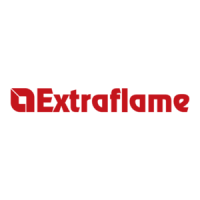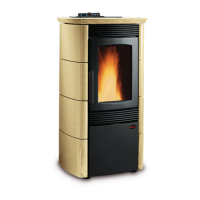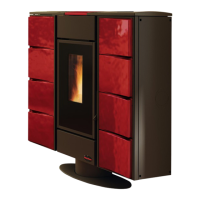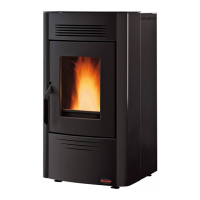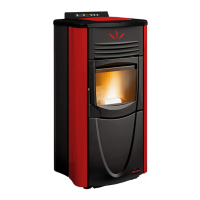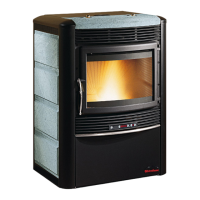Do you have a question about the Extraflame Divina Plus and is the answer not in the manual?
Guidelines for storing pellets to ensure proper combustion and prevent damage.
Automatic shutdown if warm air blower fails, preventing overheating.
Electronic unit prevents pellet feed if fume exhauster stops.
Stove continues operation until cooling level is reached if feed motor stops.
Display messages and procedures for handling lighting failures.
Appliance restarts automatically after brief power failures; potential smoke emission.
Stove protection against power surges via a master fuse.
Electronic pressure switch stops stove if exhaust system fails.
Safety device blocks operation in case of pellet hopper overheating; manual reset needed.
Definitions of key terms related to pellet stoves and installation.
General guidelines, prohibitions, and admissible conditions for stove installation.
Requirements for exhaust channels, pipes, slope, length, and bends.
Specifications for chimney/flue airtightness, materials, layout, and clearances.
Rules for connecting a single heat generator to the flue and exhaust duct.
Requirements for chimney cap design to ensure proper dispersion and protection.
Specifications for external air intake section and protection for correct operation.
Guidelines for insulation, combustible materials, and safety clearances around the stove.
Consideration of all relevant national, regional, and local laws for installation.
Description of the distributed heating feature for the Divina Plus model.
Steps for installing the Maxi Comfort insert using an optional pedestal.
Procedure for removing the insert for maintenance or servicing.
Instructions for attaching front and side frames for proper air circulation.
Requirements for air intake measurements for fireplace circulation.
Ensuring heat accumulation exits the casing to avoid insert superheating.
How the tangential fan circulates warm air created within the insert.
Creating an air entrance hole for proper convection and air loop.
Explanation of display messages, their causes, and recommended solutions.
General guidelines for using the pellet stove safely and effectively.
How to adjust heat settings, pellet consumption, and room temperature.
Specific operation details for the DIVINA PLUS model with its second motor.
Procedure for safely shutting down the stove.
Capabilities of the remote control for stove settings and operation.
Setting and function of the digital thermostat for temperature control.
Installation and operation of an optional mechanical thermostat.
Steps for connecting a mechanical thermostat to the stove.
How to operate the stove using a mechanical thermostat.
Using the Standby function to reduce pellet consumption.
Controlling the heat distribution motor with an external thermostat.
Setting up heating periods for each day of the week.
Automating stove operation based on selected day and night temperatures.
Adjusting pellet feed percentage to resolve burning issues.
Parameters for controlling the heat distribution motor in Divina Plus models.
Programming the day/night temperature settings for automatic control.
Addressing pellet feed problems like lack or excess pellets.
Settings for starting, stopping, and adjusting the heat distribution motor speed.
Cleaning procedures for burn pot, heat exchangers, and ash pans.
Monthly cleaning of the heat exchanger chamber for optimal performance.
Checking and replacing seals for hermetic sealing and correct operation.
Cleaning procedures for burn pot, heat exchangers, and ash drawer.
Cleaning procedures for burn pot, heat exchangers, and ash pans.
Cleaning procedures for burn pot, heat exchangers, and ash pans.
Information on the burn pot partition and its function.
Instructions for cleaning the chimney connection duct annually or as needed.
Conditions under which the product warranty is considered valid.
Requirements for warranty activation and validation.
Procedure for requesting warranty service and repairs.
Manufacturer's liability limitations for direct or indirect damage.
Designated court for resolving any controversies related to the product.
Guidelines for storing pellets to ensure proper combustion and prevent damage.
Automatic shutdown if warm air blower fails, preventing overheating.
Electronic unit prevents pellet feed if fume exhauster stops.
Stove continues operation until cooling level is reached if feed motor stops.
Display messages and procedures for handling lighting failures.
Appliance restarts automatically after brief power failures; potential smoke emission.
Stove protection against power surges via a master fuse.
Electronic pressure switch stops stove if exhaust system fails.
Safety device blocks operation in case of pellet hopper overheating; manual reset needed.
Definitions of key terms related to pellet stoves and installation.
General guidelines, prohibitions, and admissible conditions for stove installation.
Requirements for exhaust channels, pipes, slope, length, and bends.
Specifications for chimney/flue airtightness, materials, layout, and clearances.
Rules for connecting a single heat generator to the flue and exhaust duct.
Requirements for chimney cap design to ensure proper dispersion and protection.
Specifications for external air intake section and protection for correct operation.
Guidelines for insulation, combustible materials, and safety clearances around the stove.
Consideration of all relevant national, regional, and local laws for installation.
Description of the distributed heating feature for the Divina Plus model.
Steps for installing the Maxi Comfort insert using an optional pedestal.
Procedure for removing the insert for maintenance or servicing.
Instructions for attaching front and side frames for proper air circulation.
Requirements for air intake measurements for fireplace circulation.
Ensuring heat accumulation exits the casing to avoid insert superheating.
How the tangential fan circulates warm air created within the insert.
Creating an air entrance hole for proper convection and air loop.
Explanation of display messages, their causes, and recommended solutions.
General guidelines for using the pellet stove safely and effectively.
How to adjust heat settings, pellet consumption, and room temperature.
Specific operation details for the DIVINA PLUS model with its second motor.
Procedure for safely shutting down the stove.
Capabilities of the remote control for stove settings and operation.
Setting and function of the digital thermostat for temperature control.
Installation and operation of an optional mechanical thermostat.
Steps for connecting a mechanical thermostat to the stove.
How to operate the stove using a mechanical thermostat.
Using the Standby function to reduce pellet consumption.
Controlling the heat distribution motor with an external thermostat.
Setting up heating periods for each day of the week.
Automating stove operation based on selected day and night temperatures.
Adjusting pellet feed percentage to resolve burning issues.
Parameters for controlling the heat distribution motor in Divina Plus models.
Programming the day/night temperature settings for automatic control.
Addressing pellet feed problems like lack or excess pellets.
Settings for starting, stopping, and adjusting the heat distribution motor speed.
Cleaning procedures for burn pot, heat exchangers, and ash pans.
Monthly cleaning of the heat exchanger chamber for optimal performance.
Checking and replacing seals for hermetic sealing and correct operation.
Cleaning procedures for burn pot, heat exchangers, and ash drawer.
Cleaning procedures for burn pot, heat exchangers, and ash pans.
Cleaning procedures for burn pot, heat exchangers, and ash pans.
Information on the burn pot partition and its function.
Instructions for cleaning the chimney connection duct annually or as needed.
Conditions under which the product warranty is considered valid.
Requirements for warranty activation and validation.
Procedure for requesting warranty service and repairs.
Manufacturer's liability limitations for direct or indirect damage.
Designated court for resolving any controversies related to the product.
| Type | Pellet stove |
|---|---|
| Heating Capacity | 8 kW |
| Pellet consumption | 0.6 - 1.8 kg/h |
| Pellet Hopper Capacity | 15 kg |
| Weight | 110 kg |
| Smoke outlet diameter | 80 mm |
| Flue Gas Outlet Diameter | 80 mm |
| Fuel Type | Pellets |
| Control | Digital control panel |
| Ignition | Automatic |
| Heated volume | 230 m³ |
| Efficiency | 90% |
